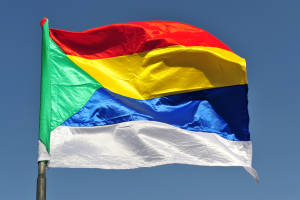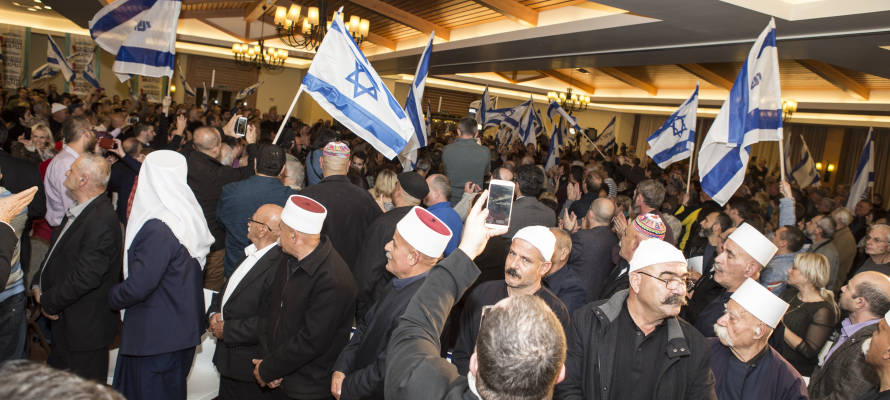Though small in size, the Druze community remains an integral component of Israeli society.
Among the minority communities of Israel are the Druze, a monotheistic religious and social community found primarily in Syria, Lebanon, Israel, and Jordan. The Druze religion is a branch of Ismailism, meaning it is a branch of Shia Islam. They believe in the unity of God, and are often known as the “people of monotheism” or simply “monotheists.” In addition to monotheism, Druze principles focus on honesty, loyalty, altruism, and patriotic sacrifice.
The Druze beliefs incorporate elements from all the Abrahamic religions as well as Gnosticism, Neoplatonism, and other philosophies. Their holy book is called the Kitab Al Hikma (Epistles of Wisdom). Their prayer houses are called the “khalwat.” The primary sanctuary of the Druze is at Khalwat al-Bayada located in Lebanon. The Druze religion is actually a secret, as one of the principles of their faith is the ban on sharing their religion with others. We know that it is purely monotheistic and they believe in the God of Abraham, Isaac, and Jacob. Some hide their faith by identifying as Muslims.
The Druze do not recognize any religious hierarchy. As such, there are no official Druze clergymen. Most Druze are not observant, and are even ignorant of their religion. In fact, observance of the religion is optional in nature. Only about 15% of Druze worldwide are observant. Observant Druze are called “uqqal” and non-observant Druze are called “juhal.”
Those who are not observant are not granted access to any of the Druze literature nor can they attend religious functions. Women “uqqal” generally wear a “mandīl,” a loose white veil, to cover their hair and wrap it around their mouths. They wear black shirts and long skirts covering their legs to their ankles. Male “uqqal” grow mustaches, and wear dark Levantine-Turkish traditional dresses, called the “shirwal.” A variety of different head coverings exist for male uqqal, each according to the individual’s seniority in the community.

The Druze flag. (ChameleonsEye/Shutterstock)
The Druze flag and primary religious symbol contain “the five colors”: green, red, yellow, blue, and white. Red symbolizes the heart and love of humanity, green symbolizes the farmer, white symbolizes purity and the air, yellow symbolizes the sun and wheat, and blue symbolizes the sky and the faith. The colors can be arranged in vertically descending stripes (as a flag) or as a five-pointed star.
There are over 125,000 Israeli Druze today, all of whom live in the north of the country. This does not include the Druze of the Golan Heights who classify themselves differently, a topic beyond the scope of this article. The largest and most famous of the Druze villages are Ussfiya and Daliyat-Al-Karmel which are the most accessible and open to visitors and tourists. Druze social customs differ markedly from those of Muslims or Christians and they are known to form a close-knit and cohesive social community but also to integrate fully in their adopted homelands.
Although the Druze are part of the Arab nation, and their first language is Arabic, they are not Muslims nor do they subscribe to Arab nationalism. They are loyal to the countries they live in. Indeed, all Israeli Druze go to the army and they have made a name for themselves as being among the fiercest fighters. Over 350 Druze soldiers have fallen in defense of the state and there is an elaborate memorial to them in Daliyat-Al-Karmel. There are currently five Druze members of Knesset – a disproportionately large number considering their population.
As Reda Mansour, the Druze poet, historian, academic, and diplomat, explained:
“We are the only non-Jewish minority that is drafted into the military, and we have an even higher percentage in the combat units and as officers than the Jewish members themselves. So we are considered a very nationalistic, patriotic community.”
Dr. Mansour was the first non-Jewish poet to write exclusively in Hebrew and is a former Israeli ambassador and current consul in Atlanta.
The Druze are known as a very mystical people including an unwavering belief in reincarnation. Although the Druze religion dates back to the 11th century, the Druze claim decent from Jethro (Nebi Schweib), father-in-law of Moses, whom they point to as the founder of their religion.
According to the Torah, Jethro temporarily joined the Jewish people in the desert and accepted monotheism. Druze tradition holds that he soon left the Jewish people returning to his own nation to spread the belief in monotheism, and with this the Druze religion began. Jethro’s tomb near Tiberias is an elaborate Druze shrine open for all to come and visit.
Rabbi Ari Enkin has studied the Druze people for many years and has visited many of the Druze holy cities throughout Israel. He has also been a guest in many Druze homes, including that of the supreme Druze spiritual leader of Israel, Sheik Muwafak Tarif, in the village of Julis.
Please SHARE with your friends and family!
